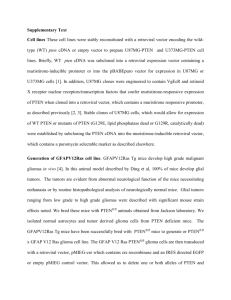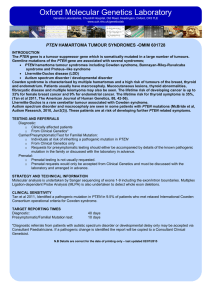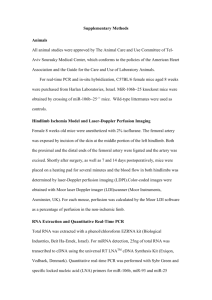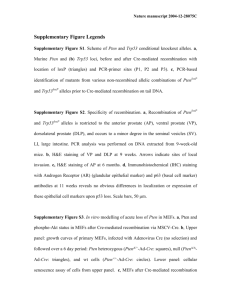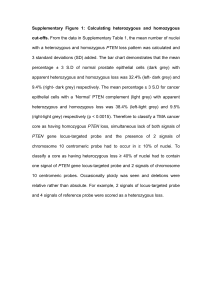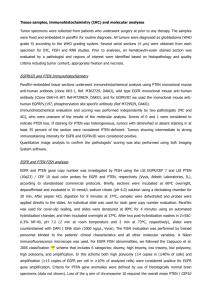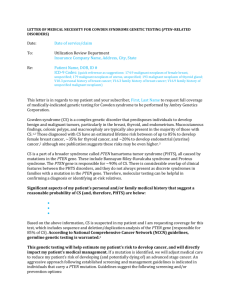Conditional Loss of PTEN Leads to Skeletal Abnormalities and Lipoma Formation
advertisement
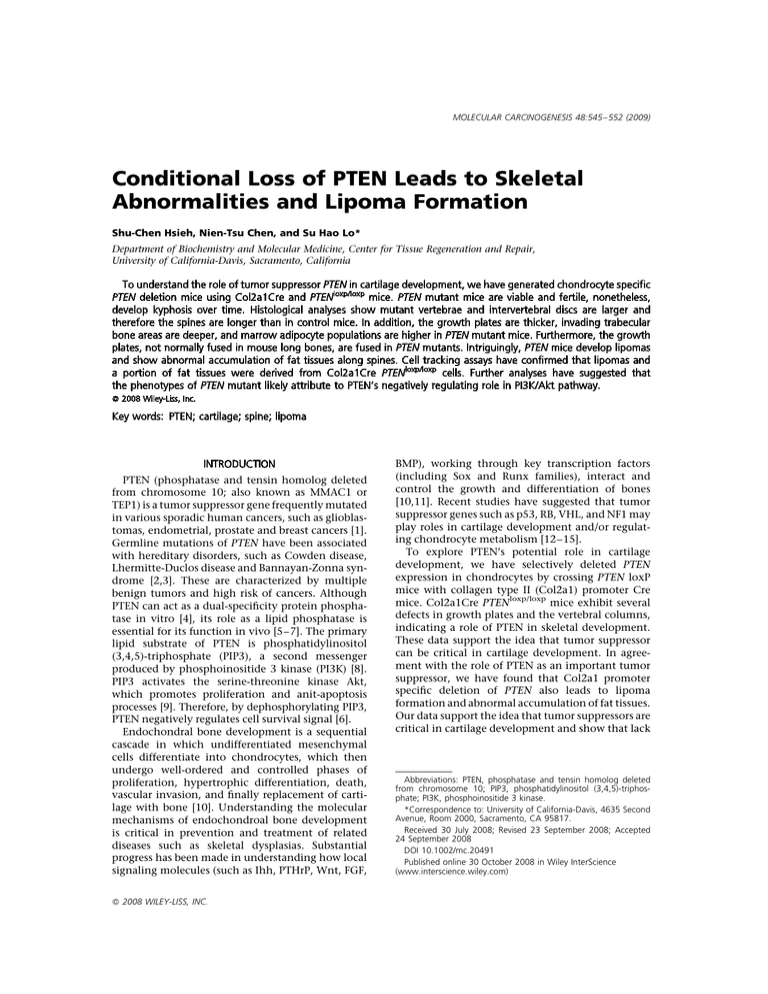
MOLECULAR CARCINOGENESIS 48:545–552 (2009) Conditional Loss of PTEN Leads to Skeletal Abnormalities and Lipoma Formation Shu-Chen Hsieh, Nien-Tsu Chen, and Su Hao Lo* Department of Biochemistry and Molecular Medicine, Center for Tissue Regeneration and Repair, University of California-Davis, Sacramento, California To understand the role of tumor suppressor PTEN in cartilage development, we have generated chondrocyte specific PTEN deletion mice using Col2a1Cre and PTENloxp/loxp mice. PTEN mutant mice are viable and fertile, nonetheless, develop kyphosis over time. Histological analyses show mutant vertebrae and intervertebral discs are larger and therefore the spines are longer than in control mice. In addition, the growth plates are thicker, invading trabecular bone areas are deeper, and marrow adipocyte populations are higher in PTEN mutant mice. Furthermore, the growth plates, not normally fused in mouse long bones, are fused in PTEN mutants. Intriguingly, PTEN mice develop lipomas and show abnormal accumulation of fat tissues along spines. Cell tracking assays have confirmed that lipomas and a portion of fat tissues were derived from Col2a1Cre PTENloxp/loxp cells. Further analyses have suggested that the phenotypes of PTEN mutant likely attribute to PTEN’s negatively regulating role in PI3K/Akt pathway. ß 2008 Wiley-Liss, Inc. Key words: PTEN; cartilage; spine; lipoma INTRODUCTION PTEN (phosphatase and tensin homolog deleted from chromosome 10; also known as MMAC1 or TEP1) is a tumor suppressor gene frequently mutated in various sporadic human cancers, such as glioblastomas, endometrial, prostate and breast cancers [1]. Germline mutations of PTEN have been associated with hereditary disorders, such as Cowden disease, Lhermitte-Duclos disease and Bannayan-Zonna syndrome [2,3]. These are characterized by multiple benign tumors and high risk of cancers. Although PTEN can act as a dual-specificity protein phosphatase in vitro [4], its role as a lipid phosphatase is essential for its function in vivo [5–7]. The primary lipid substrate of PTEN is phosphatidylinositol (3,4,5)-triphosphate (PIP3), a second messenger produced by phosphoinositide 3 kinase (PI3K) [8]. PIP3 activates the serine-threonine kinase Akt, which promotes proliferation and anit-apoptosis processes [9]. Therefore, by dephosphorylating PIP3, PTEN negatively regulates cell survival signal [6]. Endochondral bone development is a sequential cascade in which undifferentiated mesenchymal cells differentiate into chondrocytes, which then undergo well-ordered and controlled phases of proliferation, hypertrophic differentiation, death, vascular invasion, and finally replacement of cartilage with bone [10]. Understanding the molecular mechanisms of endochondroal bone development is critical in prevention and treatment of related diseases such as skeletal dysplasias. Substantial progress has been made in understanding how local signaling molecules (such as Ihh, PTHrP, Wnt, FGF, ß 2008 WILEY-LISS, INC. BMP), working through key transcription factors (including Sox and Runx families), interact and control the growth and differentiation of bones [10,11]. Recent studies have suggested that tumor suppressor genes such as p53, RB, VHL, and NF1 may play roles in cartilage development and/or regulating chondrocyte metabolism [12–15]. To explore PTEN’s potential role in cartilage development, we have selectively deleted PTEN expression in chondrocytes by crossing PTEN loxP mice with collagen type II (Col2a1) promoter Cre mice. Col2a1Cre PTENloxp/loxp mice exhibit several defects in growth plates and the vertebral columns, indicating a role of PTEN in skeletal development. These data support the idea that tumor suppressor can be critical in cartilage development. In agreement with the role of PTEN as an important tumor suppressor, we have found that Col2a1 promoter specific deletion of PTEN also leads to lipoma formation and abnormal accumulation of fat tissues. Our data support the idea that tumor suppressors are critical in cartilage development and show that lack Abbreviations: PTEN, phosphatase and tensin homolog deleted from chromosome 10; PIP3, phosphatidylinositol (3,4,5)-triphosphate; PI3K, phosphoinositide 3 kinase. *Correspondence to: University of California-Davis, 4635 Second Avenue, Room 2000, Sacramento, CA 95817. Received 30 July 2008; Revised 23 September 2008; Accepted 24 September 2008 DOI 10.1002/mc.20491 Published online 30 October 2008 in Wiley InterScience (www.interscience.wiley.com) 546 HSIEH ET AL. of PTEN expression in Col2a1 positive sites leads to lipoma formation. MATERIALS AND METHODS Generation of Mutant Mice Col2a1CrePTENloxp/loxp mice were generated by crossing Col2a1Cre mice with PTENloxp/loxp mice. Col2a1CrePTENloxp/loxp mice were further crossed with R26R reporter mice. Genotypes were determined by PCR assays with specific primers. Col2a1Cre, PTENloxp/loxp, and R26R mice were purchased from Jackson laboratory. Chondrocyte Isolation and Culture Chondrocytes were isolated from articular cartilages of femurs and tibiae by digestion in 0.25% trypsin containing 1 mg/mL type II collagenase for 30 min at 378C with constant agitation and followed by the digestion in serum free DMEM containing 1 mg/mL type II collagenase for 2 h at 378C with constant agitation. Isolated chondrocytes were further washed by DMEM containing 10% fetal bovine serum for three times and past through a cell strainer to remove the undigested tissue debris. Chondrocytes were cultured in DMEM containing 10% fetal bovine serum, penicillin (100 U/mL), streptomycin (100 mg/mL). X-Ray and Spine Measurement Mice were sacrificed at various ages and lateral radiographs of whole bodies were taken in a cabinet X-ray system Model 805 (Faxitron Inc., Wheeling, IL) at 28 Kvp, 3 mA for 10 s. Kyphosis index (KI), defined as KI ¼ AB/CD, was then measured from lateral radiographs as described [16]. AB is the length of a line drawn from anteroinferior edge of seventh cervical vertebra to the sacral promontory. CD is the farthest distance from the line to anterior border of the vertebral body. The spine lengths were measured on lateral radiographs as well from first cervical vertebra to the last lumbar vertebra. Histology, Immunofluorescence Staining, and Western Blotting Tissues were fixed in 10% neutral buffered formalin and bone samples were further decalcified in 12% EDTA followed by standard paraffin embedding procedures. Five micrometer paraffin sections were stained with hemotoxylin and eosin, or alcian blue and picrosirius red. For immunostaining, sections treated for antigen retrieval by sodium citrate method were incubated with indicated antibodies at 48C overnight. The primary antibodies were detected by the TSA system (Perkin Elmer, San Diego, CA) and fluorescence conjugated secondary antibodies and then observed under LSM510 confocal microscope (Zeiss, Thornwood, NY). PTEN, Akt and Molecular Carcinogenesis pAkt antibodies were purchased from Cell Signaling. Western blot analysis was performed as described previously [17]. For X-gal staining, tissues were fixed first in fixative solution containing 0.2% glutaraldyhyde, 2 mM MgCl2, 5 mM EGTA, 0.02% NP-40 in phosphatebuffed saline (PBS), pH 7.3 for 4 hours at 48C and then in 30% sucrose overnight at 48C, and embedded in Tissue-Tek OCT (Sakura Fintech, Torrance, CA). Sections (7.5 mm) were refixed with fixative solution and washed with solution containing 2 mM MgCl2, 5 mM EGTA, 0.01% Na deoxycholate, 0.02% NP-40 in PBS, pH 7.3. Sections were then incubated with X-gal staining buffer (5 mM potassium ferricyanide, 1 mg/mL X-gal, 2 mM MgCl2, 5 mM EGTA, 0.01% Na deoxycholate, 0.02% NP-40 in PBS, pH 7.3) for 6 h at 378C. After wash with PBS, sections were counterstained with Nuclear Fast Red. Statistical Analysis Statistical analyses were performed by using the two-sample t-test and P < 0.05 was considered statistically significant. RESULTS PTEN Deletion in Chondrocytes Leads to Spine Defects To investigate the role of PTEN in cartilage development, we have generated PTEN chondrocyte-specific deletion Col2a1Cre PTENloxp/loxp (PTEN mutant) mice by crossing PTENloxp/loxp mice with Col2a1Cre transgenic mice, in which the Cre recombinase is under the control of collagen 2a1 promoter. To confirm PTEN deletion in chondrocytes, the cartilage and other tissues such as liver from Col2a1Cre PTENloxp/loxp (PTEN mutant) mice were dissected for analyses. Polymerase chain reaction analyses had revealed the excision of the exon 5 of PTEN gene in mutant cartilage but not in liver or other tissues (data not shown). Immunofluorescent staining had confirmed that PTEN was expressed in the wild type growth plate chondrocytes and the staining was significantly reduced in PTEN mutant chondrocytes (Figure 1A). Western blot analysis of isolated chondrocytes also indicated a decreased PTEN protein level in the mutant (Figure 1B). These data demonstrate that the deletion of PTEN has occurred in chondrocytes. The PTEN mutant mice were born in an expected Mendelian genotype ratio, indicating that lack of PTEN expression in chondrocytes did not lead to embryonic lethality. The PTEN mutant mice appeared normal at birth, as judged by external appearance, body weight and general behavior. However, several abnormalities were observed over time. Overall, the adult PTEN mutant mice were more elongated and appeared thinner (Figure 2A), but the average body weight showed no statistical difference to that of control mice. PTEN IN CARTILAGE AND LIPOMA DEVELOPMENT 547 fibrosus were more rounded and less organized in PTEN mutants (Figure 2D). The sagittal sections through the center of discs showed larger discs in mutant mice as well (Figure 2D). Because both annulus fibrosus and nucleus pulposus were composed of water, collagens, and proteoglycans, which contributed to the physiological function of spines, we evaluated the distributions of proteoglycans and collagens by alcian blue and picrosirius red staining, respectively. As shown in Figure 2E, there are more proteoglycans in mutant annulus fibrosus and thicker proteoglycans layers at mutant cartilage end plates. Consistent with the above results, our histochemical staining of spines showed that mutant mice exhibited longer and wider vertebrae and intervertebral discs as well (Figure 2D), which reflected on the longer spine length we observed in PTEN mutant mice. In fact, the statistically significant of the spine length difference could be detected as early as 3 wk of age (Figure 2F). These results have demonstrated that PTEN is critical in maintaining normal distribution of mineralized matrix, cell morphologies in annulus fibrosus, and sizes of vertebrae and discs. All of these may contribute to the development and final length of spines. Lack of PTEN Expression Affects the Development of Growth Plates in Long Bones Figure 1. Deletion of PTEN in chondrocytes. (A) Growth plate sections from 3-wk-old control and PTEN mutant tibiae were stained with anti-PTEN (upper panel) or anti-pAkt (lower panel) antibodies and co-labeled with propidium iodide (PI). Significant reduction of PTEN and increase of pAkt (phosphorylated form of Akt) signals were detected in mutant growth plates. (B) Cell lysates (20 mg) prepared from isolated chondrocytes of control (CON) and PTEN mutant (MU) cartilages were subjected to western blot analyses using indicated antibodies. PTEN mutant showed a significant decrease of PTEN expression, accompanied by increased pAkt levels. [Color figure can be viewed in the online issue, which is available at www.interscience.wiley.com.] The PTEN mutant mice developed kyphosis, which could be easily observed in 8-mo-old mice (Figure 2B; shown are 14-mo-old) and the measurement of kyphosis index revealed a statistically significant difference starting at 2 mo of age (Figure 2C). The alcian blue staining of spines showed mutant vertebrae and intervertebral discs were wider and longer (not shown). The shapes of cells in annulus Molecular Carcinogenesis Cartilage growth plates in mutant long bones were slightly disorganized and more extended hypertrophic zones were detected (Figure 3A and B). In addition, we observed denser and deeper invading trabecular bone areas in all mutant samples (Figure 3A and B), which was consistent with the phenotype of larger diameter of femurs in the mutant (up to 1.6-fold larger than that in the control). Interestingly, the growth plates in mutant long bones were fused and disappeared between 5 and 8 mo of age (Figure 3C). The closure of growth plates is normal in human but never happens in wild type mice. Therefore, PTEN is required for maintaining normal growth plate structures in older mice. Furthermore, there were significant more marrow adipocytes in the mutant cavities in the 2-mo-old mice (Figure 3D) and the population increases dramatically with age. Col2a1CrePTENloxp/loxp Mice Develop Lipomas and Abnormal Accumulation of Fat Tissues Unexpectedly, we observed a swelling on the caudal part of the dorsal surface of each mutant head (Figure 4A). The morphological and histological analyses indicated that these were lipomas (Figure 4B and C), which were common benign tumors composed of adipocytes. Histological analyses have revealed various degrees of adipogenic differentiation of lipomas (not shown). Sesame size of lipoma could be observed in 3-wk-old mutant 548 HSIEH ET AL. Figure 2. Chondrocyte specific deletion of PTEN leads to spine defects. (A) The body shapes of 4.5-mo-old control (CON) and PTEN mutant male mice. (B) Lateral radiographs of 14-mo-old control and PTEN mutant male mice. (C) Kyphosis indices measured at various ages showing a statistical difference between control and mutant mice (P < 0.05). (D) H&E staining of sagittal sections of 8-mo-old discs between lumbar vertebrae 2 and 3 showing annulus fibrosus only (left two panels) or with nucleus pulposus (right two panels). Note that less organized and round shape cells are presented in annulus fibrosus of PTEN mutant. Red and black lines are shown for comparing the disc sizes. (E) Alcian blue and picrosirius red staining of same samples in (D) revealing the distribution of proteoglycans and collagens, respectively. (F) The spine lengths at various ages showed the statistical difference between control and mutant spines (P < 0.05). AF, annulus fibrosus; NP, nucleus pulposus; EP, end plate. [Color figure can be viewed in the online issue, which is available at www.interscience.wiley.com.] mice after removing the skin. The lipomas grew to palpable sizes around 1.5 mo and reached the maximum size of 1 cm in diameter around 6-moold. In addition, we observed abnormal accumula- tion of fat tissues along the spines (Figure 4B), where less fat tissues were found in control mice. It is known that Col2a1 promoter is active in early embryogenesis [18]. The activities are detected in the head Molecular Carcinogenesis 549 PTEN IN CARTILAGE AND LIPOMA DEVELOPMENT mesoderm and cell clusters of notochord in 8.75 dpc embryo and in somites, head mesenchyme, and otic vesicle region at 9.5 dpc [18]. The early deletion of PTEN in these sites may contribute to the non-skeletal related phenotypes in PTEN mutant mice. To confirm whether the development of lipomas and abnormal accumulation of fat tissues was associated with Col2a1Cre deletion of PTEN gene, the Col2a1CrePTENloxp/loxp mice were crossed with R26R reporter mice. Figure 4D indicated that all cells in lipomas showed blue X-gal staining, which indicated the history of Cre-lox homologous recombination event, demonstrating that they were all derived from PTEN deleted origins. Interestingly, the abnormal accumulated fat tissues, such as those attached to spines, showed a mixture of blue positive and negative staining. These findings suggest that lack of PTEN in head mesoderm, for example, could push cells, which do not normally differentiate into adipocytes, differentiate into the fatty tissue comprising the lipoma and also could promote preadipocytes to differentiate into adipocytes in specific locations in the body. Akt Activation in the PTEN Mutant Chondrocytes As mentioned, the well-known function of PTEN is its lipid phosphatase activity that negatively regulates the PI3K pathway. To examine whether this may contribute to the phenotypes of PTEN mutant mice, we have monitored the phosphorylation levels of Akt (pAkt), an immediate downstream molecule of the PI3K, in the growth plates. As shown in Figure 1A, we detected a significant enhancement of pAkt level especially at the hypertrophic zone, where cells underwent apoptosis. In agreement with the immunofluorescence finding, a significant increase of pAkt level was detected in isolated mutant chondrocytes. These results suggest that dysregulation of PI3K pathway may contribute to the phenotype in PTEN mutant mice. DISCUSSION In this study, we have characterized the phenotypes of Col2a1CrePTENloxp/loxp mice. The same PTEN mutant mice have been reported by Jirik’s group [19]. Overall, our results are consistent with their findings. These include kyphosis, longer spinal column lengths, growth plate abnormalities and closure in the mutant mice. Although they did not specifically mention the marrow adipocytes, Figure 5D in their article [19] also shows an increased adipocyte population in the mutant marrow cavity. However, we did not detect upper body edema described in their study and they did not observed Figure 3. Growth plates abnormalities in PTEN mutant mice. (A) H&E staining of 2-mo-old tibial cartilages shows significantly thicker and darker blue stained growth plate (GP), extended hypertrophic zone (HTZ), and denser invading trabecular bone area (I) in PTEN mutant. (B) Distributions of proteoglycans and collagens are detected by alcian blue and picrosirius red staining in 2-mo-old samples. (C) H&E staining of 14-mo-old samples detects no sign of growth plate in PTEN mutant. Arrows indicate growth plates in control. (D) Significant increased adipocytes are found in PTEN mutant marrow cavities at 2 (upper) and 8 (middle and lower with higher magnification) mo old. Arrows show areas with adipocytes. [Color figure can be viewed in the online issue, which is available at www.interscience.wiley.com.] Molecular Carcinogenesis 550 HSIEH ET AL. Figure 4. PTEN mutant mice develop lipomas and abnormal accumulation of fat tissues. (A) Gross appearance of extra protrusions (arrows) in 8 mo (left), 3 mo (middle) PTEN mutants and no protrusion in 8-mo-old control (right) mouse. (B) Skins were removed to reveal the lipoma (arrow) and accumulation of fat tissues (arrowheads) in 8-mo-old PTEN mutant. (C) H&E staining of normal fat tissues from control and lipoma in (B). (D) Lipomas and fat tissues along spines (Fat-spine) from 4.5-mo-old PTEN and PTEN/R26R mutant mice were stained for X-gal (blue) and counterstained with Nuclear Fast Red. [Color figure can be viewed in the online issue, which is available at www.interscience.wiley.com.] lipoma in their mice. At present, we do not know what factors cause the phenotypic discrepancy. Both groups used the same Col2a1Cre mice from Jackson laboratory. PTEN targeting strategies were slightly Molecular Carcinogenesis different: exon 4 and exon 5 were targeted for deletion in their mice and only exon 5 was deleted in ours, but both successfully disrupted PTEN protein expression. One potential cause might be the genetic PTEN IN CARTILAGE AND LIPOMA DEVELOPMENT factor(s), because our PTEN mutant mice were mixed with additional BALB/c genetic background. In agreement with our finding of lipoma formation in mutant mice, it has been shown that activation of PI3K pathway promotes pre-adipocytes differentiating into adipocytes and inhibition of PI3K leads to opposite results [20–22]. Furthermore, PTEN overexpression in adipocytes would sensitize the adipocytes to insulin [22]. In addition, PTEN is implicated in modulating adipocyte differentiation and function in several conditional knockout mice. For example, hepatocyte-specific PTEN null mice develop lipid accumulation in hepatocytes [23,24] and mice lacking PTEN in adipose tissues lead to insulin hypersensitivity [25]. In summary, our data presented here clearly demonstrate the important role of PTEN in spine development, growth plate organization and closure, maintaining the mineralization pattern, and balancing the normal population of marrow adipocytes. Most of these functions are likely operating through PTEN’s activity in regulating the PI3K/Akt pathway. A novel and interesting finding in this PTEN mutant mouse is the formation of lipomas and accumulation of fat tissues, which are probably due to Col2A1Cre activity and PTEN deletion in early embryonic stage and are unrelated to the cartilage development. Nonetheless, it indicates a crucial role of PTEN in adipogenesis and tumor formation. It is worthwhile mentioning that PTEN (DAF-18) has been shown to regulate longevity in Caenorhabditis elegans [26] and this lifespan control depends on PTEN-mediated regulation of PIP3 levels. Interestingly, the development of kyphosis, extensive mineralized cartilage end plates, substantial increase of marrow adipocytes, formation of lipomas, and the fusion of growth plates in our PTEN mutant mice are all related to the aging processes. At present, we do not have enough numbers to conclude the average lifespan of PTEN mutant mice. The oldest mouse we analyzed was 14-mo-old that showed physical fatigue at the time it was sacrificed. In this regard, it will be warranted to study the lifespan of PTEN mice and to determine whether PTEN mutant mice could serve as a mouse aging model. ACKNOWLEDGMENTS We are grateful to Dr. Hari Reddi for his advice and Shane Curtiss for his assistance on this study. This work is support in part by a Shriners Hospital Research Award (8580). REFERENCES 1. Dahia PL. PTEN, a unique tumor suppressor gene. Endocr Relat Cancer 2000;7:115–129. Molecular Carcinogenesis 551 2. Liaw D, Marsh DJ, Li J, et al. Germline mutations of the PTEN gene in Cowden disease, an inherited breast and thyroid cancer syndrome. Nat Genet 1997;16:64–67. 3. Marsh DJ, Dahia PL, Zheng Z, et al. Germline mutations in PTEN are present in Bannayan-Zonana syndrome. Nat Genet 1997;16:333–334. 4. Tamura M, Gu J, Matsumoto K, Aota S, Parsons R, Yamada KM. Inhibition of cell migration, spreading, and focal adhesions by tumor suppressor PTEN. Science 1998;280: 1614–1617. 5. Maehama T, Dixon JE. The tumor suppressor, PTEN/MMAC1, dephosphorylates the lipid second messenger, phosphatidylinositol 3,4,5-trisphosphate. J Biol Chem 1998;273:13375– 13378. 6. Stiles B, Groszer M, Wang S, Jiao J, Wu H. PTENless means more. Dev Biol 2004;273:175–184. 7. Rosivatz E. Inhibiting PTEN. Biochem Soc Trans 2007;35: 257–259. 8. Stambolic V, Suzuki A, de la Pompa JL, et al. Negative regulation of PKB/Akt-dependent cell survival by the tumor suppressor PTEN. Cell 1998;95:29–39. 9. Altomare DA, Testa JR. Perturbations of the AKT signaling pathway in human cancer. Oncogene 2005;24:7455– 7464. 10. Kronenberg HM. Developmental regulation of the growth plate. Nature 2003;423:332–336. 11. de Crombrugghe B, Lefebvre V, Nakashima K. Regulatory mechanisms in the pathways of cartilage and bone formation. Curr Opin Cell Biol 2001;13:721–727. 12. Iannone FC, De Bari C, Scioscia C, Patella V, Lapadula G. Increased Bcl-2/p53 ratio in human osteoarthritic cartilage: A possible role in regulation of chondrocyte metabolism. Ann Rheum Dis 2005;64:217–221. 13. Schedel J, Distler O, Woenckhaus M, et al. Discrepancy between mRNA and protein expression of tumour suppressor maspin in synovial tissue may contribute to synovial hyperplasia in rheumatoid arthritis. Ann Rheum Dis 2004;63: 1205–1211. 14. Pfander D, Kobayashi T, Knight MC, et al. Deletion of Vhlh in chondrocytes reduces cell proliferation and increases matrix deposition during growth plate development. Development 2004;13:2497–2508. 15. Kuorilehto T, Ekholm E, Nissinen M, et al. NF1 gene expression in mouse fracture healing and in experimental rat pseudarthrosis. J Histochem Cytochem 2006;54:363– 370. 16. Laws N, Hoey A. Progression of kyphosis in mdx mice. J Appl Physiol 2004;97:1970–1977. 17. Liao YC, Si L, deVere White RW, Lo SH. The phosphotyrosineindependent interaction of DLC-1 and the SH2 domain of cten regulates focal adhesion localization and growth suppression activity of DLC-1. J Cell Biol 2007;176:43–49. 18. Ovchinnikov DA, Deng JM, Ogunrinu G, Behringer RR. Col2a1-directed expression of Cre recombinase in differentiating chondrocytes in transgenic mice. Genesis 2000;26: 145–146. 19. Ford-Hutchinson AF, Ali Z, Lines SE, Hallgrimsson B, Boyd SK, Jirik FR. Inactivation of Pten in osteo-chondroprogenitor cells leads to epiphyseal growth plate abnormalities and skeletal overgrowth. J Bone Miner Res 2007;22:1245– 1259. 20. Pereira IR, Draznin B. Inhibition of the phosphatidylinositol 3’-kinase signaling pathway leads to decreased insulinstimulated adiponectin secretion from 3T3-L1 adipocytes. Metabolism 2005;54:1636–1643. 21. Aubin D, Gagnon A, Sorisky A. Phosphoinositide 3-kinase is required for human adipocyte differentiation in culture. Int J Obes (Lond) 2005;29:1006–1009. 22. Nakashima N, Sharma PM, Imamura T, Bookstein R, Olefsky JM. The tumor suppressor PTEN negatively regulates insulin signaling in 3T3-L1 adipocytes. J Biol Chem 2000;275: 12889–12895. 552 HSIEH ET AL. 23. Stiles B, Wang Y, tahl A, et al. Liver-specific deletion of negative regulator Pten results in fatty liver and insulin hypersensitivity [corrected]. Proc Natl Acad Sci USA 2004; 101:2082–2087. 24. Horie Y, Suzuki A, Kataoka E, et al. Hepatocytespecific Pten deficiency results in steatohepatitis and hepatocellular carcinomas. J Clin Invest 2004;113:1774– 1783. Molecular Carcinogenesis 25. Kurlawalla-Martinez C, Stiles B, Wang Y, Devaskar SU, Kahn BB, Wu H. Insulin hypersensitivity and resistance to streptozotocin-induced diabetes in mice lacking PTEN in adipose tissue. Mol Cell Biol 2005;25:2498–2510. 26. Gil EB, Link EM, Liu LX, Johnson CD, Lees JA. Regulation of the insulin-like developmental pathway of Caenorhabditis elegans by a homolog of the PTEN tumor suppressor gene. Proc Natl Acad Sci USA 1999;96:2925–2930.
